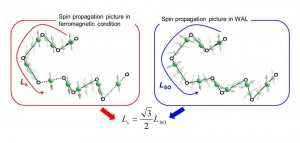A novel method to verify spin propagation length An essential prerequisite for development of spintronics devices

An electron has two degrees of freedom, charge and spin. In the fields of quantum information and spintronics, how far an electron can transfer that spin information, i.e., the spin propagation length, is an essential parameter in terms of application in future spintronics devices. However, there is no well-established method for obtaining this length; values reported so far differ greatly depending on the experimental method employed, the number of variables involved in the definition of the spin propagation length and so on. Since the spin propagation length determines the spin Hall angle, which is one of the most important parameters in the field of spintronics, it is of great importance to evaluate this length correctly.

Spin propagation lengths measured with ferromagnets (LS; left) and obtained from weak antilocalization (WAL) measurement (LSO; right). The relation of the two length scales (LS = √3/2 LSO) has been experimentally verified. © Yasuhiro Niimi
Professor YoshiChika Otani, Associate Professor Takeo Kato, Assistant Professor Yasuhiro Niimi and colleagues at the University of Tokyo’s Institute for Solid State Physics have discovered a new way to evaluate the spin propagation length. Conventional methods use a spin valve structure where a spin propagation material is bridged by two ferromagnets. In this case, there are several parameters that determine the spin propagation length, which is not always straightforward to evaluate. In the new method, on the other hand, the propagation length can be evaluated just by measuring very precisely the resistance of a spin propagation material. In metals, electrons are weakly localized at temperatures approaching absolute zero. This weak localization depends on the interaction between the spin and orbit of electrons. In the present work, the researchers focused on this dependency and obtained the spin propagation lengths of several materials. The values obtained with the new method are quantitatively consistent with those from conventional methods. Since the new method reduces the number of variables involved in determining spin propagation length, a more accurate value can be calculated. In addition, it has been shown theoretically that the spin propagation length in a localized state and under ferromagnetic conditions varies slightly, and a formula describing that relationship has been determined. This research is also the first time that that formula has been experimentally demonstrated, and the spin propagation length values obtained under ferromagnetic conditions have been explained. Thanks to these results, a vigorous debate on the spin propagation length can be concluded and this new method will play an important role in the fields of quantum information and spintronics.
Press release [PDF] (Japanese)
Paper
Yasuhiro Niimi, Dahai Wei, Hiroshi Idzuchi, Taro Wakamura, Takeo Kato, and YoshiChika Otani,
“Experimental Verification of Comparability between Spin-Orbit and Spin-Diffusion Lengths”,
Physical Review Letters 110, 016604 (2013). Online Edition: 2013/1/3 (Japan time), doi: 10.1103/PhysRevLett.110.016805.
Article link






